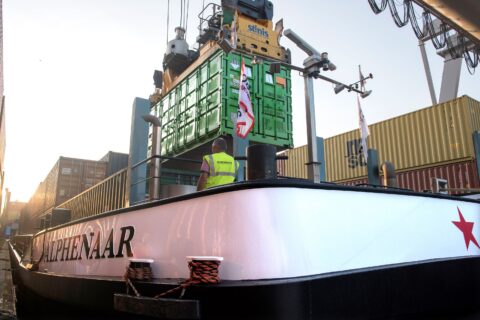Zero Emission Services (ZES) has started sailing the Alphenaar. It is the first Dutch inland navigation vessel that uses exchangeable energy containers for its propulsion. The Alphenaar will sail between Alphen aan den Rijn and Moerdijk for Heineken brewery, the first end customer of ZES.
This marks the commissioning of the innovative energy system from ZES for inland navigation. The energy containers, so called “ZESpacks”, are standard 20ft containers filled with batteries, which are charged with green electricity.
The first two ZESpacks will be loaded and swapped at the first loading station at CCT’s terminal in Alphen aan den Rijn. ZES has the ambition to scale up in the short term to eight ships, eight charging stations and fourteen ZESpacks and wants to realise thirty zero emission shipping routes by 2030. Founded last year by ENGIE, ING, Wärtsilä and the Port of Rotterdam Authority, with the support of the Ministry of Infrastructure and Water Management, the company is taking an important step in the transition towards emission-free inland shipping.
Also read: Interchangeable batteries to ‘electrify’ Dutch inland navigation
Pay per use
ZES provides a complete service package based on exchangeable energy containers with green energy, open-access charging infrastructure and a pay-per-use payment concept for ship owners. The charging stations can function as energy hubs that can stabilise the grid at peak load times and where other vehicles can also charge. Because of their mobility, ZESpacks can be used to supply and store energy at all kinds of locations, such as construction sites and festivals.
‘The energy concept put on the market by ZES contributes directly to the reduction of emissions by saving about 1000 tonnes of CO2 and 7 tonnes of NOx per ship per year. Moreover, ships sailing with ZES produce no fine dust or noise,’ says Willem Dedden, CEO of ZES.

Ten-year contract with Heineken
The investment in ZESpacks is borne by ZES. This set-up makes ZES very user-friendly and scalable. Dedden: ‘ZES offers governments and companies a ready-made solution to increase sustainability’.
One of those companies is Heineken, which, together with carrier CCT, is the first customer of ZES with a ten-year contract. ZES arose from the Green Circles (Groene Cirkels) project to realise a climate-neutral container shuttle between the Heineken brewery in Zoeterwoude and the port of Rotterdam.
Ready for hydrogen and ammonia
Dedden: ‘In addition to contributing directly to the realisation of emission-free inland navigation, ZES sets a standard that accelerates the transition to emission-free inland navigation. With our ZESpack (a standard 20 ft container) and a standard connector (the ‘plug’) we are laying the foundation. In combination with the financing and pay-per-use package devised by ING, ZES offers skippers a low-threshold, future-proof open access innovation. The ZESpacks system adapts as technology improves: the ZESpacks currently in use work with Lithium-Ion batteries, but in the future this could also be hydrogen, ammonia or something else. The ZESpack always fits the connection, regardless of the type of energy in the container.’
For this reason, ZES is releasing the templates for the connector free of charge, so that the market can work with various suppliers of energy containers.
From construction to sailing
Wärtsilä, supplier of the first ZESpacks, worked in recent months on assembling and testing the energy containers, which are equipped with safety and communication systems, and 45 battery modules totalling 2MWh – comparable to the capacity of some 36 electric cars. The ZESpack is fully customised for ZES.
Also read: Wärtsilä to develop autonomous, zero-emission barge for Port of Rotterdam
Especially unique is the interchangeability of the containers, which until now have been stationary installations. The ZESpacks are loaded with certified green electricity at the first ZES loading station at the Alpherium, CCT’s container terminal in Alphen aan den Rijn. This charging station, developed by ENGIE, was completed in April.
In July, the Alphenaar was refitted and among other things equipped with the standard connector to receive the ZESpacks. At the end of August, the first successful trial run took place. With the start of operations, ZES will be gaining user experience in the coming period in order to achieve fully emission-free sailing as soon as possible.
Pictures by Ries van Wendel de Joode.








